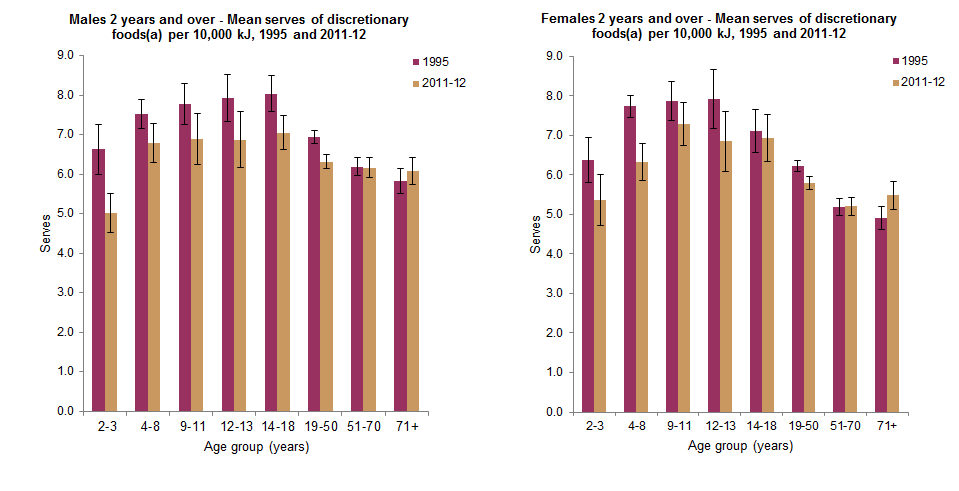DISCRETIONARY FOODS
While the preceding sections did consider discretionary foods, the context was limited to demonstrating the extra serves of ADG food groups available if discretionary forms of those foods were included in addition to the non-discretionary. This section compares overall consumption and sources of discretionary foods between 1995 and 2011-12 and thus provides the complimentary part of the dietary picture to the non-discretionary consumption. Unlike the preceding section however, the analysis of discretionary foods cannot use the ADG database1 and therefore comparisons of specific food types is limited to comparable AUSNUT 2011-13 and AUSNUT 1999 food groups.
As with non-discretionary foods, ‘serve’ amounts can be calculated for discretionary foods.2 In 1995, the population consumed a daily average of 6.6 discretionary serves per 10,000 kJ. By 2011-12, average discretionary serve consumption had fallen to 6.1 per 10,000 kJ. The largest reductions in discretionary food consumption occurred in children, with a reduction of almost one serve (0.9) per 10,000 kJ for the 2-18 year olds. Adults had an average reduction of 0.3 serves, although this came entirely from the younger adults (19-50 years), with no change in the 51-70 years and an increase of 0.5 discretionary serves in the 71 years and over group.

(a) Based on Day 1. See Glossary for definition.
Sources: National Nutrition and Physical Activity Survey, 2011-12 and National Nutrition Survey, 1995
For children, the food groups reduction which made the greatest contribution to the decline in discretionary energy were cordials and soft drinks (together accounting for 30%), potato products (e.g. fries/ hot chips) (18%), discretionary breakfast cereals (11%), while reductions in ice cream and pastries each accounted for 9% of the decline. For adults, a reduction in potato products accounted for 24% of the decline in discretionary energy, followed by cordials and soft drinks (18%) and pastries (18%). On the other hand, some discretionary foods counted relatively more towards discretionary energy in 2011-12 than 1995, most notably wine which accounted for 7% of adult’s discretionary energy in 2012, up from 4% in 1995.
ENDNOTES
 Print Page
Print Page
 Print All
Print All